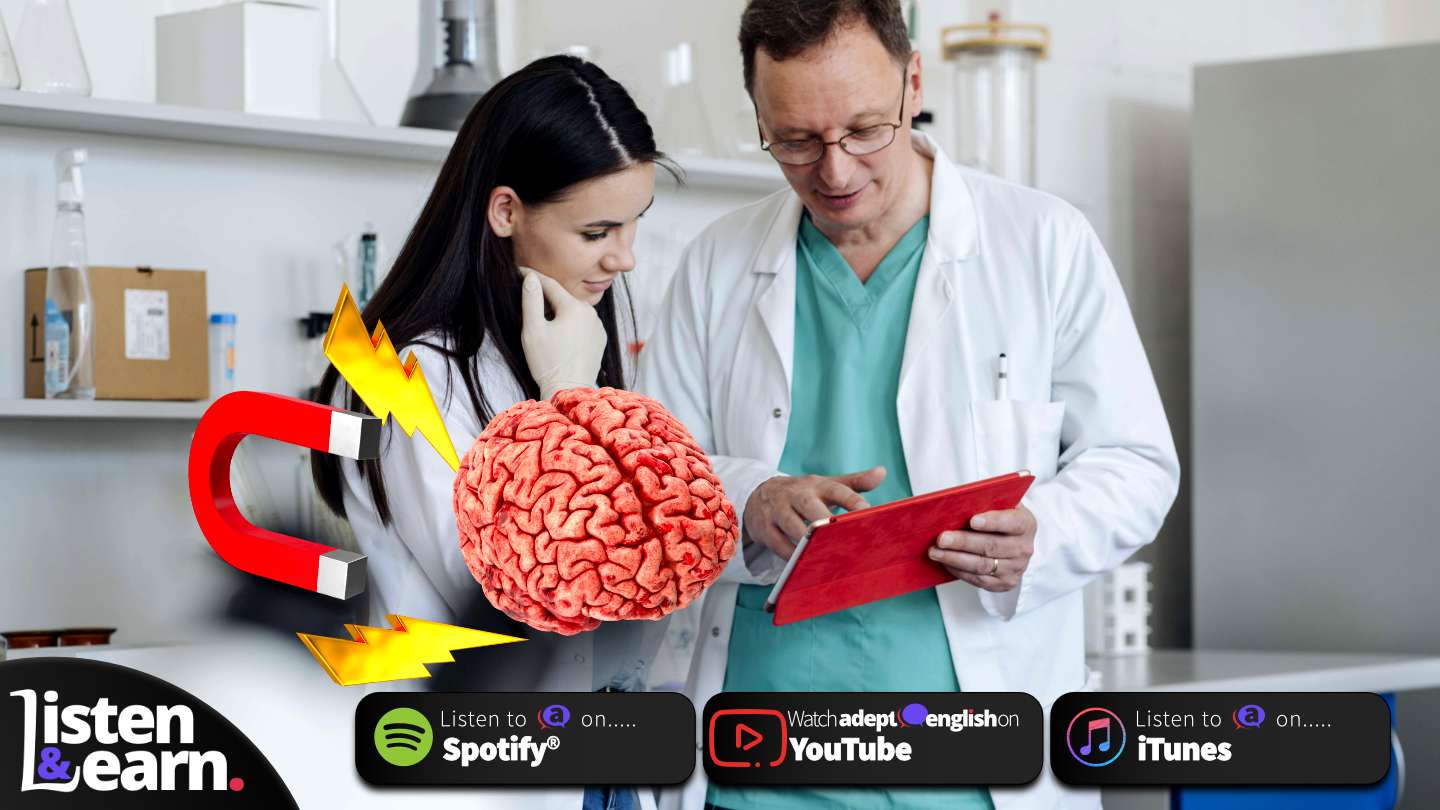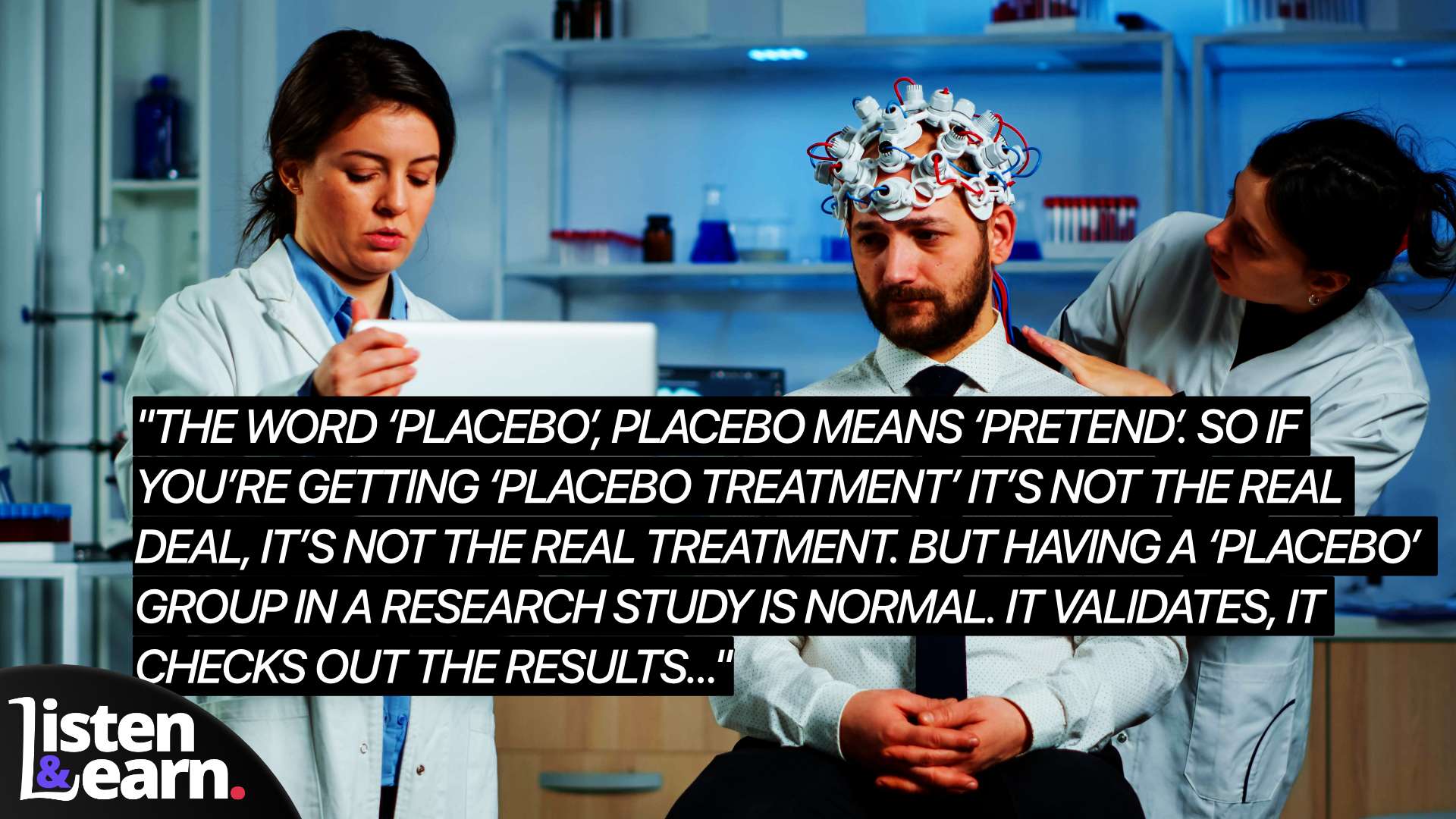Get Your Brain Tingling With English Listening Practice
I’m back with another episode of English Listening Practice. English listening practice is never boring, with Adept English! Today we’re going to mess with your mind.… in a good way! This is a great English listening practice lesson, designed for English language learners. If you want to improve your English language skills, are interested in new brain science, put on your headphones and press play.
Neuroscience is making some amazing progress and I’m going to talk about this progress and an accidental discovery that may help people on the autistic spectrum. Listening to our podcasts will help you practice active listening while you expand your vocabulary, strengthen your accent and improve your pronunciation.
Learning this way is a more natural way to acquire a language. It’s the same way you learned your own native language. There are lots of benefits to this approach to language learning. You’ll sound smarter, more confident and will communicate at a higher level in English.
If you want to improve your listening skills in English, our website has are some of the best online listening practice lessons on the internet. They’re great for ESL students and people wanting to keep their English language skills in tiptop condition.
Most Unusual Words:
Autistic
Tiptop
Spectrum
Psychotherapy
Nutrition
Cranium
Stimulate
Neurons
Mood
Serotonin
Dopamine
Placebo
Most common 2 word phrases:
| Phrase | Count |
|---|---|
| The Brain | 5 |
| A New | 3 |
| One Of | 3 |
| Lots Of | 3 |
| Of Course | 3 |
| Internal Experience | 2 |
| Affected By | 2 |
| Physical Brain | 2 |
| Our Understanding | 2 |
| Our Genetics | 2 |
| Our Brains | 2 |
| Human Beings | 2 |
| We Might | 2 |
| We Use | 2 |
| On Neuroscience | 2 |
| Talking Therapy | 2 |
| Tiptop Condition | 1 |
Listen To The Audio Lesson Now
The mp3 audio and pdf transcript for this lesson is now part of the Adept English back catalogue . You can still download and listen to this lesson as part of one of our podcast bundles.Transcript: English LISTENING PRACTICE That Will Mess With Your Mind
Well, the Adept English podcast is here primarily to help you with learning English, but many of you tell me that you particularly like my podcasts on the brain and on neuroscience. So as you know, if you listen regularly - this is one of my favourite topics too, so I love making podcasts on this. So here we go today with a dual-purpose podcast again.
Practise your English understanding, your English comprehension, while listening to something interesting on neuroscience at the same time!
Hello, I’m Hilary, and you’re listening to Adept English. We will help you to speak English fluently. All you have to do is listen. So start listening now and find out how it works.
Human beings have complex psychology
So as a psychotherapist, I do ‘talking therapy’ with people. People who are anxious or depressed or who have other psychological difficulties. And lots of these difficulties do respond to what has been known since Sigmund Freud as ‘The Talking Cure’. We use many other theories, beyond Freud, of course. But I’m always aware too that our brains are complex and though many problems are addressed by ‘talking therapy’ or psychotherapy, it really is only part of the picture.
What determines how we are as human beings and how we behave and what our internal experience is like - well, it’s down to lots of things. As I’ve spoken about in a previous podcast, we might be affected by trauma - remember podcast 478 where I talked about the trauma work of Dutch born Psychiatrist, Bessel Van der Kolk? We’re also affected psychologically by our genetics, particularly by mutations or changes in our genetics which we all have. Also by our diet, our nutrition - meaning what we eat. And our psychology is affected of course, by our personal experiences and history and our physical brain.
We’re affected by how the brain is physically functioning. And science is making great progress at the moment, learning more and more about the physical brain. Of course, we really are just at the start of understanding how the brain works, but it’s really exciting. We have MRI scans and lots of other ways of collecting information now about our brains.
This knowledge, this understanding, well it’s relevant to all of us. It’s about our human condition. It determines our understanding of ourselves and of other people. ‘Brain’, BRAIN is the physical organ, the ‘grey matter’ and we use the word ‘mind’, MIND to talk about the psychology, the internal experience, what we and others experience of the way we are.
One direction of research - Transcranial Magnetic Stimulation
And study of the brain is whizzing along in all kinds of different directions. There are so many exciting areas to talk about! When a new idea, a new experiment or a new treatment appears, it’s often not well understood, but we might learn surprising things from it. Each development takes our understanding further, sometimes in surprising directions.
One of these ideas, a concept which has become a treatment for the brain in the last few years, is Transcranial Magnetic Stimulation or TMS. It’s one of those which scientists aren’t quite sure how it works. But it does do something to our brain! Vocabulary here - ‘Transcranial’? Well ‘trans’ means ‘across’ and your ‘cranium’, CRANIUM is your ‘skull’ - the bone, which sits around your brain.
The round part of your head is your ‘cranium’. ‘Magnetic’, MAGNETIC just means ‘using magnets’. And ‘stimulation’ comes from the verb ‘to stimulate’, STIMULATE. In science, to stimulate generally means ‘to excite, to increase activity in’ something. And here, that’s the brain. So again, that’s Transcranium Magnetic Stimulation or TMS. Let’s talk about what that is.
Video
How brain internal communication happens
So parts of your brain communicate using nerve cells or ‘neurons’. That’s NEURONS. And it’s been known that neurons function through chemical and electrical signals. Electrical signals are used to move information along neural pathways, whereas chemical signals are used to transfer information between neurons that are next to one another. And it was in the 1980s that Dr Antony Barker of Sheffield University in the UK, first tried experiments with Transcranial Magnetic Stimulation of various parts of the brain. The ‘subject’, the person, the patient if you like, is conscious, so this gave rise to some interesting experiences.
What is Transcranial Magnetic Stimulation and how is it used?
So electrodes or ‘electrical connections’ are stuck onto the person’s skull or cranium - their head in other words. And then a weak current of electricity is passed through. The current ‘pulses’ and repeats. And this way, particular parts of the brain can be stimulated. So Transcranial Magnetic Stimulation or TMS is now used to treat various psychological problems. Problems like depression, trauma, addiction, eating disorders, OCD and many more might be treated with TMS.
The idea being, for example in something like depression, if you stimulate the parts of the brain which control mood, you might make the person feel better. We use the word ‘mood’, MOOD to mean how happy or how sad a person is. So if you have depression, we would say you had ‘low mood’. Or we might talk about ‘mood swings’. So the idea with something like depression, is that if you use TMS to stimulate the neurotransmitters, the chemicals if you like, in certain areas of the brain, this will produce more neurotransmitters - so the person will feel better.
So examples of the neurotransmitters that you may have heard of - serotonin, SEROTONIN. That’s the neurotransmitter, or brain chemical which makes us feel sociable and friendly and jolly. Dopamine, DOPAMINE is the neurotransmitter which makes us feel enthusiastic and gives us pleasure. So theoretically, if a depressed person had more of each of these neurotransmitters, they might feel better!
TMS - not a ‘cure-all’ for depression
So I’ve said that Transcranial Magnetic Stimulation is used for example as a treatment for depression. It’s not certain how effective it is. Some research studies on TMS suggest that although the patients get a little better, the effect wasn’t much greater than on a placebo group.
The word ‘placebo’, PLACEBO means ‘pretend’. So if you’re getting ‘placebo treatment’ it’s not the real deal, it’s not the real treatment. But having a ‘placebo’ group in a research study is normal. It validates, it checks out the results - sometimes in a study everyone improves, just because they’re in a research study! So you have to allow for that and factor that in.
📷
A photograph of scientists monitoring a man's brain activity. Hello and welcome to an English Listening Practice podcast designed for English language learners.
It’s starting to be very clear that there are many different reasons why people become depressed. And there are several different types of depression, even at the brain level. It’s not ‘one size fits all’. Although it’s been the theory for a long time, it’s not now certain that depression is always to do with neurotransmitters like serotonin and dopamine - there are other reasons for it. This is why anti-depressants work for some people and not for others - because they mainly work on serotonin.
Success of TMS for depression?
So with TMS, about 30% of people find the treatment makes their depression go away altogether. It isn’t permanent - it lasts for about a year. That’s a pity - but if you suffer depression, a year without it is certainly worth having. And with TMS 50-60% find that it makes some difference. Clearly this is better than the statistics for anti-depressants. And the current TMS treatments may be just a step along the way towards other treatments that are more effective.
A quick reminder of The Seven Rules of Adept English
In a minute, I’ll talk about TMS and Autism - which is really interesting! But first just a reminder that if you like the Adept English podcast, it’s a good idea to do our free course The Seven Rules of Adept English to make sure that you’re using the podcasts in the best way for your English language learning.
Boost Your Learning With Adept English
These Seven Rules give you brilliant tips for language learning - and ensure that you get most benefit from using our podcast material. If you haven’t done this course yet, you’re missing out - it’s free! So go to our website at adeptenglish.com and you can sign up for this free course today.
Some thoughts on Autistic Spectrum Disorder
So what really interests me about TMS is the effect it has when it’s used on people with Autism or Autistic Spectrum Disorder - that’s ASD. I’ve covered the topic of autism before, in podcast 452. It’s something which is very common and we probably all know someone, who has ASD or Autistic Spectrum Disorder. How often this is recognised and diagnosed probably depends upon where in the world you live. Another form is Asperger’s.
As I said in podcast 452 ‘People on the autistic spectrum may not be warm and spontaneous with their emotions, especially with people they don’t know. People with ASD don’t always see the so-called ‘social cues’ – which means social signals, like when someone wants you to leave or when someone is joking perhaps.’
A person with Asperger’s may be awkward in social situations and prefer time alone. It may be hard to make friends and they may have ‘restricted interests’ - that’s where someone focuses on a very narrow subject and becomes expert in it. People with Aspergers and ASD are often ‘good at detail’, but find ‘the big picture’ difficult. Restricted interests and repetitive behaviours can be very calming to someone with ASD – so routine and ‘things remaining the same’ can be important.
The effect of Transcranial Magnetic Stimulation on ASD
So you are perhaps familiar with what ASD is like - or you may have it yourself. As I’ve mentioned previously, Greta Thunberg is a famous person who has Asperger’s. It’s not something you need to see as a negative - it just means ‘a different way of being’. But what happens when you use TMS on someone who has Autistic Spectrum Disorder? Well, for me this is the really fascinating part.
The effect is said to be of ‘waking up the emotions’. This at least was the experience of one man who’s written about it, who was diagnosed with Autism in his 40s. John Elder Robison volunteered as a subject for TMS research at Beth Israel Deaconess Medical Center in Boston. After the first session of TMS, he thought nothing was different. Then, when he was in his car on the way home, he realised that music was completely different for him - full of emotion! He started to think about why the music was written, by whom and what it meant.
Download The Podcast Audio & Transcript
With further experimental sessions of TMS, further changes came. In particular, the ability to sense other people’s feelings became at times overwhelming, whereas previously John Elder Robison’s responses would have been much more practical, much more logical. He wouldn’t have tuned in to the feeling of the other person in the same way. He would’ve known it was there, but not particularly attended to it.
The treatment brought out in him an automatically more compassionate, sympathetic, empathic response to other people’s emotions. He saw them automatically, whether he wanted to see them or not and found himself automatically responding to them. This hadn’t happened before. So in some senses, John Elder Robison felt that he was worse off. The Autism provided a ‘protection’ - it meant that he didn’t have to be so aware of other people’s emotions, other people’s pain. It worked as a sort of ‘protective shield’. And life was very different, once it wasn’t there - it seemed like a permanent change.
’Waking up emotions’ and the difficulties of this
I guess if you’ve been having these responses to other people all your life, you’ve got ways of dealing with it. But if you have ASD and the effect of Transcranial Magnetic Stimulation is suddenly to ‘switch this on’, it’s probably really difficult to deal with! I find this really interesting! It’s almost as though TMS can ‘switch on’ parts of the brain that weren’t functioning much, which weren’t working in in this way previously.
You might ask whether you would actually want to do this if you had autism? In a way, you’d have feelings, and emotions that perhaps you don’t have the capacity to manage. On the other hand, some of the ‘social difficulties’ which people with ASD can have, might be easier in our world of ‘neurotypical’ people.
Goodbye
I think there’s a lot more to say and talk about here, but this is probably enough for one podcast. So let me know if you find this subject interesting and if you’d would like more on it.
Enough for now. Have a lovely day. Speak to you again soon. Goodbye.
Thank you so much for listening. Please help me tell others about this podcast by reviewing or rating it. And, please share it on social media. You can find more listening lessons and a free English course at adeptenglish.com
Links
- Learn English While Understanding Yourself Ep 478
- Understanding Autism An English Speaking Practice Topic Ep 452
- More English listening practice lessons
- Does Transcranial Magnetic Stimulation Work?
- The Success Rate of TMS Therapy
- TMS: Hope for stubborn depression
- Efficacy of SSRIs and newer antidepressants
- Autism After Magnetic Stimulation
- Human Consciousness Is... Electromagnetic?
- Can TMS Unlock Emotions
- Find us on Spotify
- Read along on YouTube
- Apple Podcasts
- Find our 🎧 podcast on other platforms here 👈
- FREE English language course
- 7 Rules Of Adept English
- Listen & Learn
- More English lessons to help you improve your English










